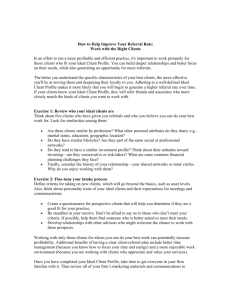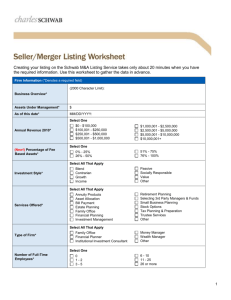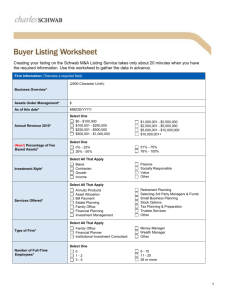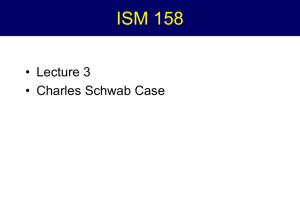The Publisher`s Page
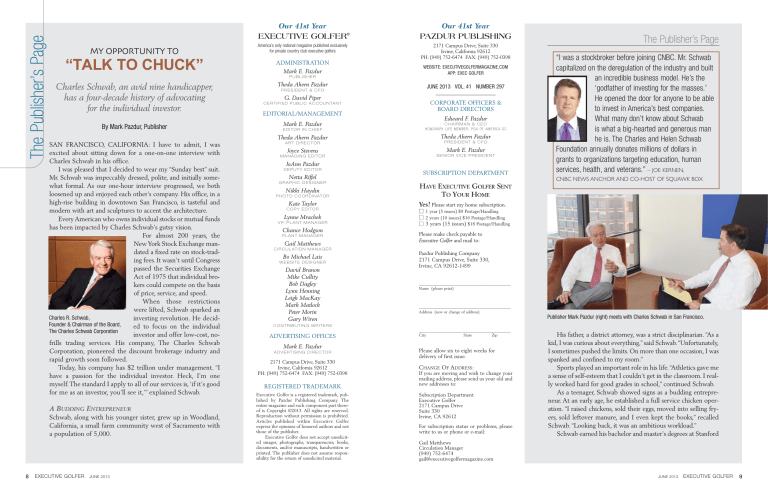
MY OPPORTUNITY TO
“TALK TO CHUCK”
Charles Schwab, an avid nine handicapper, has a four-decade history of advocating for the individual investor.
By Mark Pazdur, Publisher
SAN FRANCISCO, CALIFORNIA: I have to admit, I was excited about sitting down for a one-on-one interview with
Charles Schwab in his office.
I was pleased that I decided to wear my “Sunday best” suit.
Mr. Schwab was impeccably dressed, polite, and initially somewhat formal. As our one-hour interview progressed, we both loosened up and enjoyed each other’s company. His office, in a high-rise building in downtown San Francisco, is tasteful and modern with art and sculptures to accent the architecture.
Every American who owns individual stocks or mutual funds has been impacted by Charles Schwab’s gutsy vision.
For almost 200 years, the
New York Stock Exchange mandated a fixed rate on stock-trading fees. It wasn’t until Congress passed the Securities Exchange
Charles R. Schwab,
Founder & Chairman of the Board,
The Charles Schwab Corporation
Act of 1975 that individual brokers could compete on the basis of price, service, and speed.
When those restrictions were lifted, Schwab sparked an investing revolution. He decided to focus on the individual investor and offer low-cost, nofrills trading services. His company, The Charles Schwab
Corporation, pioneered the discount brokerage industry and rapid growth soon followed.
Today, his company has $2 trillion under management. “I have a passion for the individual investor. Heck, I’m one myself. The standard I apply to all of our services is, ‘if it’s good for me as an investor, you’ll see it,’” explained Schwab.
A B
UDDING
E
NTREPRENEUR
Schwab, along with his younger sister, grew up in Woodland,
California, a small farm community west of Sacramento with a population of 5,000.
Our 41st Year
EXECUTIVE GOLFER
®
America’s only national magazine published exclusively for private country club executive golfers
ADMINISTRATION
Mark E. Pazdur
P U B L I S H E R
Theda Ahern Pazdur
P R E S I D E N T & C F O
G. David Piper
C E R T I F I E D P U B L I C A C C O U N TA N T
EDITORIAL/MANAGEMENT
Mark E. Pazdur
E D I T O R I N C H I E F
Theda Ahern Pazdur
A R T D I R E C T O R
Joyce Stevens
M A N A G I N G E D I T O R
JoAnn Pazdur
D E P U T Y E D I T O R
Netta Riffel
G R A P H I C D E S I G N E R
Nikki Haydin
P H O T O C O O R D I N AT O R
Kate Taylor
C O P Y E D I T O R
Lynne Mrachek
V P, P L A N T M A N A G E R
Chance Hodgson
P L A N T M A N A G E R
Gail Matthews
C I R C U L AT I O N M A N A G E R
Bo Michael Lais
W E B S I T E D E S I G N E R
David Branon
Mike Cullity
Bob Dagley
Lynn Henning
Leigh MacKay
Mark Matlock
Peter Morin
Gary Wiren
C O N T R I B U T I N G W R I T E R S
ADVERTISING OFFICES
Mark E. Pazdur
A D V E R T I S I N G D I R E C T O R
2171 Campus Drive, Suite 330
Irvine, California 92612
PH: (949) 752-6474 FAX: (949) 752-0398
REGISTERED TRADEMARK
Executive Golfer is a registered trademark, published by Pazdur Publishing Company. The entire magazine and each component part thereof is Copyright ©2013. All rights are reserved.
Reproduction without permission is prohibited.
Articles published within Executive Golfer express the opinions of honored authors and not those of the publisher.
Executive Golfer does not accept unsolicited images, photographs, transparencies, books, documents, and/or manuscripts, handwritten or printed. The publisher does not assume responsibility for the return of unsolicited material.
8 EXECUTIVE GOLFER
JUNE 2013
Our 41st Year
PAZDUR PUBLISHING
2171 Campus Drive, Suite 330
Irvine, California 92612
PH: (949) 752-6474 FAX: (949) 752-0398
WEBSITE: EXECUTIVEGOLFERMAGAZINE.COM
APP: EXEC GOLFER
JUNE 2013 VOL. 41 NUMBER 297
CORPORATE OFFICERS &
BOARD DIRECTORS
Edward F. Pazdur
C H A I R M A N & C E O
H O N O R A R Y L I F E M E M B E R , P G A O F A M E R I C A S C
Theda Ahern Pazdur
P R E S I D E N T & C F O
Mark E. Pazdur
S E N I O R V I C E P R E S I D E N T
SUBSCRIPTION DEPARTMENT
H
AVE
E
XECUTIVE
G
OLFER
S
ENT
T
O
Y
OUR
H
OME
Yes!
Please start my home subscription.
■
1 year (5 issues) $9 Postage/Handling
■
2 years (10 issues) $16 Postage/Handling
■ 3 years (15 issues) $18 Postage/Handling
Please make check payable to
Executive Golfer and mail to:
Pazdur Publishing Company
2171 Campus Drive, Suite 330,
Irvine, CA 92612-1499
______________________________________________________
Name (please print)
______________________________________________________
Address (new or change of address)
______________________________________________________
City State Zip
Please allow six to eight weeks for delivery of first issue.
C HANGE O F A DDRESS :
If you are moving and wish to change your mailing address, please send us your old and new addresses to:
Subscription Department
Executive Golfer
2171 Campus Drive
Suite 330
Irvine, CA 92612
For subscription status or problems, please write to us or phone or e-mail:
Gail Matthews
Circulation Manager
(949) 752-6474 gail@executivegolfermagazine.com
The Publisher’s Page
“I was a stockbroker before joining CNBC. Mr. Schwab capitalized on the deregulation of the industry and built an incredible business model. He’s the
‘godfather of investing for the masses.’
He opened the door for anyone to be able to invest in America’s best companies.
What many don’t know about Schwab is what a big-hearted and generous man he is. The Charles and Helen Schwab
Foundation annually donates millions of dollars in grants to organizations targeting education, human services, health, and veterans.”
– JOE KERNEN,
CNBC NEWS ANCHOR AND CO-HOST OF SQUAWK BOX
Publisher Mark Pazdur (right) meets with Charles Schwab in San Francisco.
His father, a district attorney, was a strict disciplinarian. “As a kid, I was curious about everything,” said Schwab. “Unfortunately,
I sometimes pushed the limits. On more than one occasion, I was spanked and confined to my room.”
Sports played an important role in his life. “Athletics gave me a sense of self-esteem that I couldn’t get in the classroom. I really worked hard for good grades in school,” continued Schwab.
As a teenager, Schwab showed signs as a budding entrepreneur. At an early age, he established a full service chicken operation. “I raised chickens, sold their eggs, moved into selling fryers, sold leftover manure, and I even kept the books,” recalled
Schwab. “Looking back, it was an ambitious workload.”
Schwab earned his bachelor and master’s degrees at Stanford
JUNE 2013
EXECUTIVE GOLFER 9
The Publisher’s Page
“Chuck is one of the great leaders in American finance. This was not by accident or luck. He has been successful decade after decade. He is smart, a true visionary, and a wonderful gentleman. I am proud of what we accomplished at Stock Farm. When we were designing the course, I often asked myself,
‘What were Chuck’s expectations for the end product?’ I think we exceeded those expectations.
The course at Stock Farm is not overblown, it is a solid, quality test of golf.”
– TOM FAZIO
Stock Farm is a 2,600 acre, private, golf-based retreat near Hamilton, Montana. The centerpiece of the club is its Tom Fazio designed course and rustic 27,000 log-cabin construction clubhouse. Other amenities include a spacious equestrian center and 30 miles of mountain trails. Wildlife is an important part of life at the community. Stock Farm is located on the ancestral wintering grounds for great elk herds. Some 500 of these magnificent animals live on-site. Also nearby is the Bitterroot River, teeming with rainbow and brown trout. For more information visit StockFarm.com.
University in spite of dyslexia. “It wasn’t until I was 40 years old when my seven year old son was diagnosed with dyslexia that I realized I suffered from the same disorder.
I thought,” sighed Schwab, “this was just the way the brain processed information.”
D
EMOCRATIC
C
APITALISM
Schwab opened his first office in 1971. Searching for his niche, the company grappled for direction.
When the industry was deregulated in the mid-
1970s, Schwab saw an opportunity to target individual investors and lower the commission structure by more than 50 percent. Other revolutionary initiatives established by his company included no-fee retirement accounts and no-load mutual funds for mom-and-pop investors. By 1981, Schwab had over 600 employees and annual revenue of $42 million.
“I believe in democratic capitalism. With our low fee structure, anyone can buy into corporate America. We
10 EXECUTIVE GOLFER
JUNE 2013 have reduced and, in most cases, eliminated all barriers for the individual to be able to afford to own stocks,” beamed Schwab.
D
ON
’
T
W
ORRY
, I W
ON
’
T
S
PEND
I
T
Schwab learned to play golf as a young boy at Yolo Fliers
Club in California. “I tended to play more golf with Mom than Dad,” said Schwab. “She took the brunt of my temperament on the course.”
In high school he played on the Santa Barbara varsity golf team and, as a senior, won the individual CIF title. “Al
Geiberger was our number one player and I was number two,” continued Schwab.
Golf at Stanford University wasn’t an option. “I was realistic,” explained Schwab. “To be proficient on the freshman team, a full-time commitment was required. I had to hold down a part-time job and couldn’t dedicate that many hours to practice.
“In order to earn extra money during summer breaks,
The Publisher’s Page
I held various jobs, including working as a railroad switchman and an oil-field roustabout. Definitely, not your typical office jobs,” smiled Schwab.
Schwab now cards about 80 rounds per year and holds a nine handicap. One of his favorite playing partners is Phil Mickelson. “It is a real pleasure to play with
Phil. He is smart and has a great sense of humor,” explained Schwab. “The last time we teed it up at Stock
Farm in Montana, he gave me seven shots and I won a buck! When Phil handed me the dollar, I told him I won’t spend it. I knew it wouldn’t be long before he earned it back.”
Not surprisingly, Schwab rubs shoulders with major power players in Washington. He was recently paired with
John Boehner, Speaker of the House, for a round at San
Francisco Golf Club. “I think it was a nice escape for him,” said Schwab. “I don’t need to tell you the political turmoil that was simmering at the time. We were partners in a tournament and we won.”
When I asked him what the topic of conversation was between shots, he was surprisingly candid. “Politics definitely was not a big focus. It was an informal discussion, not unlike what you would have with your regular Saturday foursome. We talked about sports, business, and strategy to beat the competition.”
A G
REAT
W
AY
T
O
S
PEND
A D
AY
W
ITH
M
Y
G
RANDCHILD
Schwab has owned a ranch in the Bitterroot
Valley of Montana since the early 1980s.
“The region has much to offer,” explained
Schwab. “It’s a gateway to the largest wilderness area in the lower 48 states and the Valley had every conceivable outdoor activity except one—a quality, private golf experience.”
So, Schwab organized a group of friends to come together and build an ultra-exclusive, private golf community with a Tom Fazio golf course named Stock Farm.
“Those of us who are founding members of Stock
Farm feel it is a true realization of our original vision,” detailed Schwab. “We've come here to embrace and live out the eternal values of the West, and to invest our lives in a place as rock solid as its surrounding mountains. The meticulous way our community has grown ensures it will remain and thrive for generations.
“To me, catching strong trout with my grandchildren and then having the club’s executive chef prepare our bounty for a family meal is one of the best ways I could ever spend my day.”
A P
RECIOUS
H
AWAIIAN
J
EWEL
The warm trade winds of Hawaii are equally attractive to
Schwab as the expansive wilderness in Montana. To com-
“Chuck’s support led to the formation of the prestigious Charles Schwab Cup at
Desert Mountain in Arizona. It offers the biggest prize on the Champions Tour. As a trustee of The First Tee, his generosity has helped it grow into an organization that has impacted millions of kids by teaching them important life skills through golf. Additionally, he has been a tremendous champion for the game in San Francisco, especially in helping bring the
2009 Presidents Cup to Harding Park.”
– TIM FINCHEM, COMMISSIONER, PGA TOUR
JUNE 2013
EXECUTIVE GOLFER 11
The Publisher’s Page
“The development of ETFs (exchange traded funds) has reduced the growth rate of mutual funds.
It is a natural evolution and there is room for both. Some investors prefer the lower cost, passive management of ETFs while actively managed mutual funds often produce greater returns than the market as a whole. I recommend some of each for a well-balanced, diversified portfolio.”
– CHARLES SCHWAB plement his retreat at Stock Farm, Schwab partnered with George Roberts, one of the three original partners of Kohlberg Kravis
Roberts (KKR), to build Nanea on the Big
Island of Hawaii.
“It has always been a dream of mine to develop a private club in a sunny resort destination. Hawaii is so pleasant. The people are caring, the culture is inviting, and a stark landscape against the blue waters of the Pacific Ocean are surreal.
“The land we chose for Nanea had few
The 8th hole on the Nanea golf course, Big Island of Hawaii natural defenses. With no trees and few bushes, I knew the bunkering and natural terrain would be critical to designing a course worthy of receiving top rankings from golf’s governing organizations,” said Schwab. “David McLay Kidd had just designed Bandon Dunes so we took a chance on him.”
Guy Lam, Mr. Schwab’s good friend, placed the initial call to Kidd in Scotland.
“David, we are interested in having you design our course in Kona, Hawaii,” relayed Lam.
“I would love to hear more about the opportunity, but
I am about to sit down for dinner at my mom’s house,” replied Kidd.
Somewhat perturbed, Lam fires back, “You must not be interested in the job, you aren’t taking me seriously.”
Kidd responded, “You don’t know my mom!”
After a chuckle, Lam reveals the scope of the project and the principal behind it.
Kidd wasn’t familiar with the Charles Schwab brand.
“At first, I thought it was Les Schwab, known for his car
Charles and Helen Schwab tire franchise in the Pacific Northwest
(where Bandon Dunes is located),” winced Kidd. “Growing up in Scotland, I had never seen the ‘Talk to Chuck’ commercials so prevalent on American television. My naivety as a young Scotsman was apparent.”
Two days later, Kidd had dinner with
Schwab in Hawaii. “Working with Chuck and his wife Helen was a pleasure. They are gems of human beings. Helen’s active involvement was a pleasant surprise. She did a number of tours with me on the golf course and I think her input created a better course.”
“At the time, Kidd was relatively unknown and unproven,” remembered Schwab. “Ultimately he was the perfect match for our vision.”
T
HE
A
DVANTAGE
O
F
A
GE
Schwab seems resolute about
America’s bright future. “We are now in the aftermath of one of the greatest economic crisis our country has faced,” explained Schwab. “The leverage some corporations and banks built into their business models for the sake of more profits proved to be their downfall.
Fortunately, I have always managed our company conservatively and we were able to weather the storm.
“I’ve been through several economic and political crisis during my career. In fact, I had just started my company when President Richard Nixon resigned. I guess with age comes wisdom. We will face unforeseen challenges in the future, but I am confident our company is well honed to deal with them.”
As our interview wrapped up, I asked Schwab for his best financial advice. “Diversification is the mantra of investing, but you must also be persistent and patient,” advised Schwab. “Investors are much like golfers. To be successful, you need to be optimistic that tomorrow will always be a better day.
“I am bullish on America. The entrepreneurial spirit that is so prevalent in our society is alive and well.” ■
12 EXECUTIVE GOLFER
JUNE 2013
